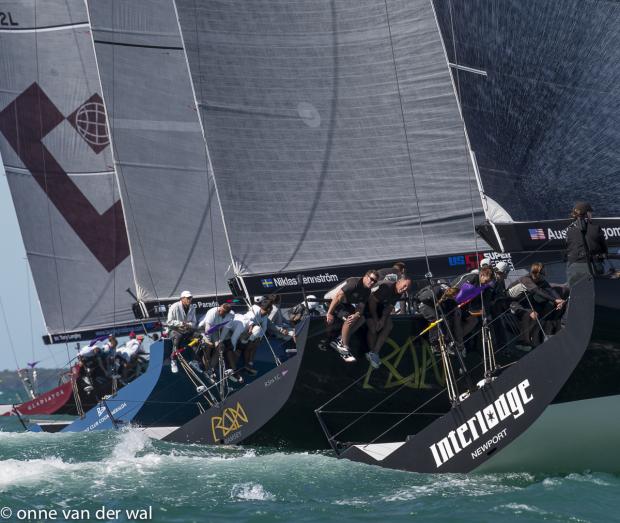**

**
Tell us about this shot.
We don’t get to see TP52’s together much in the United States. You will sometimes see one or two but Key West Race Week this year was special because we had so many. To be able to shoot the transoms all lined up at the start showed how close the racing was. Especially with the TP52, it’s unique to get 4 boats so close together.
Starts are a great place to take pictures because you get a lot of action and multiple boats in one shot. The biggest challenge is to make sure no other chase boats go in front of you: I like to set up about a boatlength above the committee boat but it can be quite crowded with spectator boats, mark boats and other photo boats, not to mention the boats that are racing. I sometimes have to move two or three boatlengths up but you have to be really careful to stay out of the port tack zone. The key to going where you want to is hiring your own photo boat—I’ve worked with this driver for many years—it gets expensive but is worth it. I am a big fan of general recalls as you can shoot the start again and maybe this time from the pin end.
What are your favorite shooting conditions?
Just before they decide to call off the racing due to too much breeze. They’re also the hardest conditions to work in, but I get some of the best pictures when it’s blowing 20, the sun’s coming in and out of the clouds, and there’s a big sea running. You have to have a good chase boat driver or a good helicopter pilot. It’s best if you can get the direction of the sun and breeze to work so it’s not right behind you but more at an angle. Big breeze and waves make for killer starts and great action on the race course.
How do you protect your gear from all of these elements?
I have a big plastic case by SKB that I bring on the boat. I take 4 cameras (Canon’s professional top of the line model) on the water each with a different lens, and they all sit like sardines in the box. It has a rubber seal, and I can flop it closed and that keeps out the spray and waves. I can work very quickly with this system, and I keep a few rags to wipe the cameras if they get a little wet. I bring a separate waterproof bag for clothes, food, water, and anything else. The box is just for the cameras.
Have you ever had a gear catastrophe?
Yes. I was sitting on the leeward side of one of the older 12 Meters. The boat was well heeled and I had my shoulder leaning against one of the stanchions. All of a sudden the base of the stanchion weld gave way and over teh side I went, camera and all! Luckily I’m a good swimmer, and I didn’t let go of the camera as I knew I’d need proof for the insurance company, plus I had a bunch of good shots on that card that I wanted to save. That was about an $11,000 accident. The insurance company almost dropped me for that one.
Do you know right away when you get a good shot, or are you surprised when you load the pictures at the end of the day?
I know when it’s going right. You definitely know. This will be my 26th year shooting sailboats. Aftern that amount of time on the job you definitely get the hang of it.
Any tips for processing a full day’s photos?
I first download the pictures to the computer and then renumber and rename them in a program called Photo Mechanic. I then I pick the ones I like. Once I’ve narrowed it down I take the files into Adobe Lightroom and convert them from raw files to jpegs. In Lightroom I always add a little black and increase clarity.
The advantages of digital photography are that you never run out of film and as long as you’re shooting pretty close to the right exposure, you can correct the photos on the computer. The disadvantages are that everything—both cameras and computers—is more expensive now, and people want the photos the same day you shoot them. The days of getting off the boat and going for a swim and having a beer are over, you have to go straight to the hotel to load and process the images. But at the end of the day I think my work is much better since I switched to digital.
How do you pick which prints will go in the Newport gallery?
The gallery was my wife’s idea and she runs it, so I actually have nothing to do with the selection of prints. We make a good team because she takes care of picking images, framing, the calendar, and all that. I get to focus on taking the pictures.
Do you enjoy your work?
I’m very lucky to be able to work in a career I love. Of course there are some days when it’s hard going or boring, but at least 95% of the time I love what I do. I don’t make a ton of money, but I make enough to keep the wheels turning and everyone fed. And when everyone else is shoveling snow in their driveways, I get to travel south!
Want to learn from the expert? Onne van der Wal teaches workshops with groups of four to twelve students. Check out his website, vanderwal.com, for more information on a workshop near you.
Check out Onne van der Wal’s pictures from Key West Race week: Day 1, Day 2, Day 3, Day 4, Day 5









